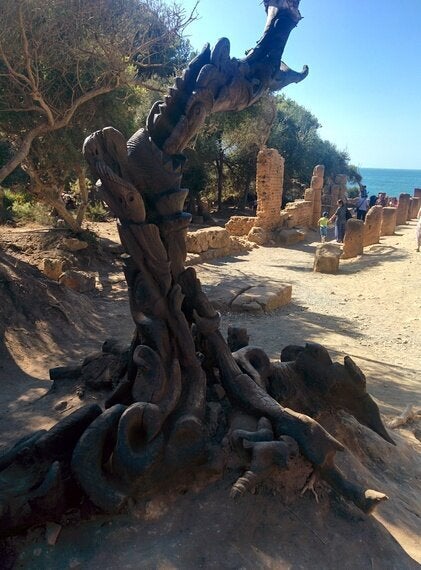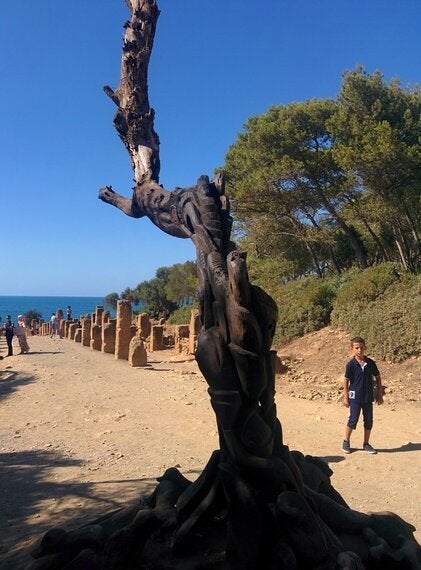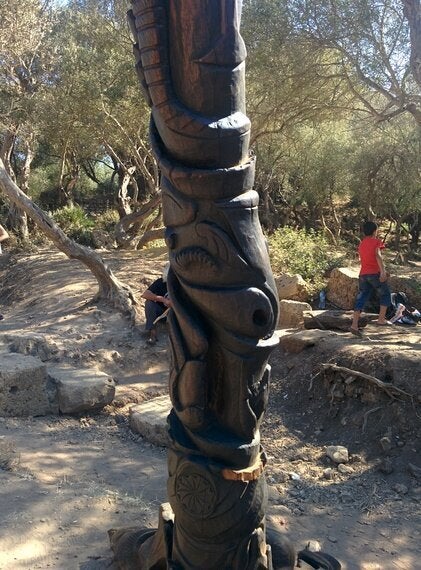A tangled branch and a bent twig that can distort the imagination and send it into overdrive. How the mind of an artist truly works is something that can never be put into words; rather the creation speaks volumes. And indeed, that is so with Djeloul Esahli, resident and artist of Tipaza.
In North Africa, the Romans left their mark in three areas of modern day Algeria; two main land cities and one coastal. This coastal city being Tipaza.
Tipaza, a beautiful city that hugs the Mediterranean Sea, was adored by the philosopher and Pied-Noir Albert Camus. And rightly so. Scattered are remnants of a once great empire that lived and ruled in ancient Roman Mauretania Caesariensis. Cliff edges cup the flowing sea as small environments of sea life bob up and down in the shallow waters, which visitors can now enjoy via a cliché boat ride.
The UNESCO heritage site froths at the mouth of the sea with ancient history, and at every turn there is something new to view and notice. Each time I have ventured to the site, something new appears to the forefront of my detail inspired mind. However, this time, it was a double take.
The Artist
Djeloul Esahli, a modest craftsman sets up his place each morning on the crumbling ruins of Tipaza with carving tools at hand: an ornately decorated carving knife and mallet rest tranquilly on the dusty floor as Esahli looks for his next piece of work.
A craftsman by trade, Djeloul Esahli began his career as a carver of intricate banisters for homes and apartments. It was a simple transition from work to passion that made this man so fond of the art he consumes his days with now. Taking pieces of wood from branches of trees, sometimes the stump of the tree itself, Esahli begins a creative journey of pattern and story through lines, swirls and details that would take you more than one notice to see them all.

And it's true. Upon discovering his elaborate art all over the trees, I had to talk to him, if only between each chip of his wood block. Kindly, he agreed to chat.
His lineage
A true Tipazian, Esahli's family hail all from the city of Tipaza. He reports that in 1884, his Grandfather was born in Tipaza. At this time, Algeria was under French occupation, and many Algerians did not have family names. Rather, they were known via their fathers, for example 'Bou Smail' (Father of Smail). This patriarchal naming still exists across North Africa and the Middle East. The French named families with no naming records based on their locations or living standard. The Elsahli's were given this name based on the Arabic word El-Sahel, meaning coastline. The coasters of Tipaza.
His Creations
As people began to bustle towards his creations slowly but surely, his eyes began to dart towards his tools, as I queried more. How does he think of his creations? How does the curve turn into a sharp point?

His answer is poignant, and very true. The shape and the form of the wood doesn't always end up as you intended to begin with. Why? "parce que le matin c'est le matin, et le soir et le soir" (the morning is the morning, and the evening is the evening). Each stage in the process is different.

What was obvious to begin with may become lost and bring to light something completely different. That's the charm in his work. Each layer of the wood changes colour and texture, so he moves with the grain.

The artist is often forgotten, and sometimes the artist prefers to stay incognito. Their voice is through the concrete form rather than the sound of their own voice. Though Djeloul Elsahli doesn't speak much of his art, his pieces in Tipaza are an asset that one cannot pass without admiring. This man deserves more than a few pity dinars in his hat.
Some people think that this sort of lifestyle is fantastical. Or delusional. Many, if not most people, tend to believe that artistry is for airy-fairy people, lacking direction. The dreamers. I disagree.
Maybe I say this because art inspires us. It makes us look a little deeper, ask a few more questions and the beauty in it being subjective means there are a million and one different stories to be told; all from the same piece of art.
Thank you Djeloul Esahli. From one Algerian to another.
